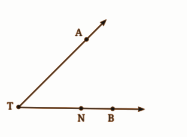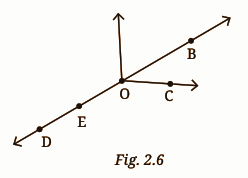Lines And Angles Questions and Answers - Free PDF Download
FAQs on NCERT Solutions For Class 6 Maths Chapter 2 Lines And Angles Exercise 2.4 - 2025-26
1. What do Vedantu's NCERT Solutions for Class 6 Maths Chapter 2, Lines and Angles, provide for students?
Vedantu's NCERT Solutions for Class 6 Maths provide detailed, step-by-step explanations for every question in the Lines and Angles chapter. These solutions are crafted by subject experts in line with the CBSE 2025-26 curriculum, focusing on the correct methodology to help students understand concepts and solve problems accurately.
2. How should I correctly name an angle in my exam as per the NCERT method?
The solutions demonstrate that an angle must be named using three letters. The letter representing the vertex (the point where the two arms of the angle meet) must always be in the middle. For an angle with vertex B and arms BA and BC, the correct name is ∠ABC or ∠CBA. This precise naming is essential for scoring full marks.
3. How do the NCERT Solutions use diagrams to help solve problems on intersecting and parallel lines?
The solutions include clear and accurately labelled diagrams to help you visualise the problem. For instance, when solving a question about intersecting lines, the diagram will clearly mark the point of intersection. This visual aid simplifies complex problems and reinforces the theoretical concepts learned in the chapter.
4. What is the correct way to solve problems distinguishing between a line and a line segment?
The NCERT solutions emphasise the use of correct notation. A line, which extends infinitely in both directions, is denoted with arrows (e.g., ↔AB). A line segment has two fixed endpoints and is denoted by a bar over the letters (e.g., AB). The solutions apply this distinction to solve problems, ensuring you understand how to represent and use them correctly in your answers.
5. Why is it important to follow the step-by-step problem-solving method shown in these NCERT Solutions?
Following the step-by-step method is crucial because it builds a logical approach to problem-solving. In geometry, the process is as important as the final answer. This structured method, guided by CBSE norms, ensures you do not miss any critical steps, leading to a complete, accurate, and high-scoring answer while strengthening your foundational understanding.
6. How do the NCERT Solutions help identify the vertex and arms of an angle in a complex figure with many angles?
In complex figures, the solutions teach you to first isolate the specific angle the question asks for. They then guide you to identify the common point as the vertex and the two rays or line segments originating from it as the arms. This systematic approach prevents confusion and helps you accurately deconstruct and analyse complicated diagrams.
7. What is a common mistake students make when identifying the interior and exterior of an angle, and how do the solutions clarify this?
A common mistake is incorrectly classifying a point that lies exactly on the arms of the angle. The NCERT solutions prevent this by clearly defining the regions:
- The interior is the space between the arms.
- The exterior is the space outside the arms.
- The angle itself consists of the points on the arms. The step-by-step examples ensure you can correctly classify any given point.
8. Apart from finding correct answers, what other skills do I develop by practising with these solutions?
By consistently using these solutions, you are not just memorising answers but are developing crucial skills. You enhance your visualisation ability, logical reasoning, and attention to detail. Mastering the methods shown in the solutions builds a strong foundation in geometry, making it easier to tackle more advanced topics in higher classes like Class 7 and 8.

































